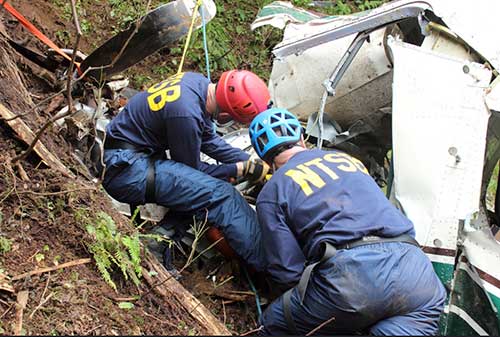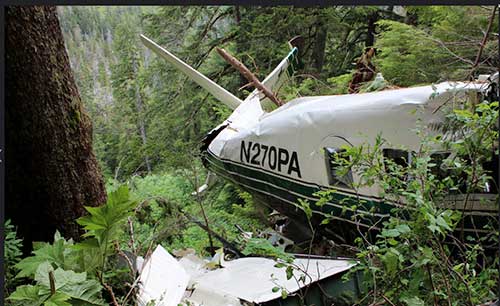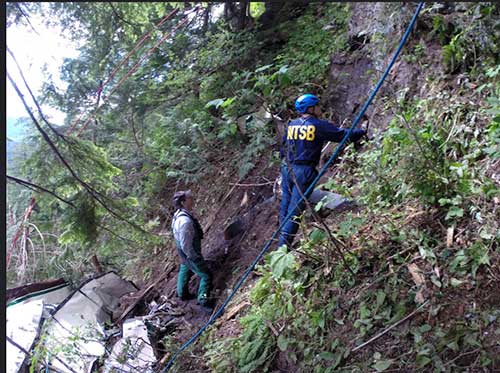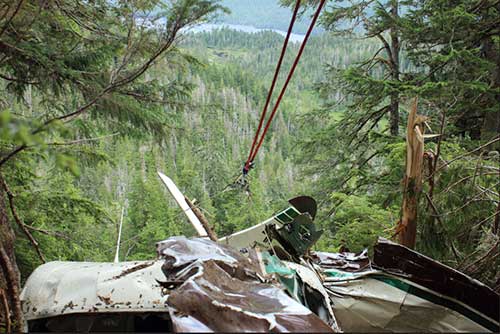
NTSB Releases Preliminary Report of Sightseeing Plane CrashBy MARY KAUFFMAN
July 08, 2015
Those who died in the Misty Fjord's crash were identified as the commercial pilot and eight passengers. Fatally injured were Rowland Hal Cheney, 71, and Mary Doucette, 59, both of Lodi, CA; Glenda Cambiaso, 31, and Hugo Cambiaso, 65, both of North Potomac, MD; June Kranenburg, 73, and Leonard Kranenburg, 63, both of Medford, OR; Margie Apodaca, 63, and Raymond Apodaca, 70, both of Sparks, NV; Pilot Bryan Krill, 64 of Hope, ID.
NTSB investigators Brice Banning and Clint Crookshanks on scene examining the wreckage of a sightseeing plane that crashed in Alaska on June 25, 2015.
The National Transportation Safety Board sent a go-team from its Alaska Regional office to investigate the sightseeing plane that crashed near Ketchikan. Leading the team as investigator-in-charge is NTSB investigator Brice Banning. The downed airplane was being operated as an on-demand visual flight rules (VFR) sightseeing flight when the accident occurred said the NTSB. The airplane was owned by Pantechnicon Aviation, of Minden, Nevada, and operated by Promech Air, Inc., of Ketchikan. The NTSB wrote in the preliminary report that marginal visual meteorological conditions were reported in the area at the time of the accident. The flight departed a floating dock located in Rudyerd Bay about 44 miles northeast of Ketchikan about 12:00 PM for a tour through Misty Fjords National Monument Wilderness. A company VFR flight plan was in effect. At the time of the accident, the flight was returning to the operator's base at the Ketchikan Harbor Seaplane Base, Ketchikan.
DeHavilland DHC-3T (Turbine Otter) that crashed on June 25, 2015 near Ketchikan, Alaska while on a sightseeing tour.
Shortly after the crash, Holland America Line suspended sales of the flightseeing tour operated by Promech out of Ketchikan but still continues to offer other flightseeing excursions with other operators. The NTSB's report said the operator reported that the accident airplane departed Rudyerd Bay as the third of four float-equipped airplanes on air tour flights over the Misty Fjords National Monument Wilderness. The airplanes departed about 5 minutes apart, and the standard route of flight was southwest, over an area of remote inland fjords, coastal waterways, and mountainous tree-covered terrain. When this airplane failed to return to Ketchikan, the operator initiated a search for the missing airplane and heard an emergency locator transmitter (ELT) signal along the accident pilot's anticipated route of flight. The downed aircraft was operated by Ketchikan-based Promech Air a local charter, tour and flightseeing business. Promech Air is the largest air taxi in southern Southeast Alaska.
NTSB investigator Clint Crookshanks and a member of the Ketchikan Volunteer Rescue Squad at the site of a sightseeing plane that crashed in Alaska on June 25, 2015.
The NTSB investigator-in-charge along with another NTSB investigator, with help from The Ketchikan Volunteer Rescue Squad, reached the accident site on the morning of June 27th. The airplane impacted trees and a near vertical rock face in a nose high, wings level attitude at an elevation of about 1,600 feet mean sea level and came to rest upright on top of its separated floats, in an area of heavily forested, steep terrain.
Wreckage of a sightseeing plane that crashed in Alaska on June 25, 2015.
The accident airplane was equipped with a Pratt & Whitney PT6A-135A engine that produces 750 shaft horsepower. A comprehensive NTSB postaccident examination of the engine and airframe is pending, after the airplane wreckage is recovered and brought to Ketchikan. The closest weather reporting facility is the Ketchikan Airport, about 24 miles southwest of the accident site. At 11:53 AM on June 25th, an aviation routine weather report (METAR) at Ketchikan reported in part: wind 130 degrees at 15 knots, gust 23 knots; visibility 6 statute miles, rain and mist, runway 11 visual range 4,000 variable to greater than 6,000 feet; few clouds 800 feet, broken clouds 1,200 feet, overcast clouds 2,700 feet; 61 degrees F; dew point 57 degrees F; altimeter 29.91 in Hg. It may take up to a year before the final accident report is released. The cause of the crash has not been officially determined although it appears weather may have been a contributing factor. There is an FAA Flight Service Station based in Ketchikan; however, there are no air traffic controllers based in Ketchikan. Most of Alaska has few air traffic control towers. There are 4 in the Anchorage area, 3 in the Fairbanks area, and another 6 scattered out across the rest of the state for a total of 13 statewide. Anchorage Air Route Traffic Control Center (ARTCC) airspace covers the entire state of Alaska. According to public information provided by the Federal Aviation Administration, Ketchikan is designated as a special rule area requiring two-way radio communications with the Ketchikan Flight Service Station (FSS) prior to operating in the surface area. Additionally, due to the confined airspace and volume of traffic, specific patterns have been developed for fixed wing aircraft and helicopters based on wind direction and place of landing/takeoff.
Source of News:
|
||



